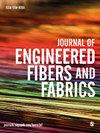Thermal properties, microstructure analysis, and environmental benefits of basalt fiber reinforced concrete
IF 2.3
4区 工程技术
Q1 MATERIALS SCIENCE, TEXTILES
引用次数: 0
Abstract
Numerous scientists have studied basalt fiber (BF) reinforced concrete and found encouraging results. However, information is scattered, and compressive assessment is yet necessary to collect the data from prior research on BF, present research advancement, and future research guidelines of BF reinforced concrete. Furthermore, mostly research focus to review on strength and durability aspects of BF reinforced concrete while no researched focus on thermal properties, microstructure analysis and environmental benefits of BF reinforced concrete. Therefore, the primary focuses of this paper are BF treatment, BF reinforced concrete performance at high temperatures, microstructure analysis, environmental advantages, and application in civil engineering. Results show that BF-reinforced concrete performs much better than traditional concrete at high temperatures. Additionally, the use of BF enhanced the heat conductivity of concrete. BF addition to concrete seems to have reduced interfacial transition zone (ITZ) fractures, according to a microstructure study. When opposed to traditional steel fibers, BFs may be thought as reinforcements that are less harmful to the environment. The study also highlights the significance of BFs in the building industry. The assessment also identified research gap research for further studies.玄武岩纤维混凝土的热性能、微观结构分析和环境效益
许多科学家对玄武岩纤维(BF)增强混凝土进行了研究,并发现了令人鼓舞的结果。然而,信息是分散的,压缩评估仍然有必要从BF的先前研究、BF钢筋混凝土的当前研究进展和未来的研究指南中收集数据。此外,研究主要集中在BF钢筋混凝土的强度和耐久性方面,而没有集中在BF混凝土的热性能、微观结构分析和环境效益方面。因此,本文主要关注高炉处理、高炉钢筋混凝土高温性能、微观结构分析、环境优势以及在土木工程中的应用。结果表明,BF钢筋混凝土在高温下的性能明显优于传统混凝土。此外,BF的使用提高了混凝土的导热性。根据微观结构研究,BF添加到混凝土中似乎减少了界面过渡区(ITZ)断裂。与传统的钢纤维相比,BFs可以被认为是对环境危害较小的增强材料。该研究还强调了BFs在建筑行业的重要性。评估还确定了有待进一步研究的研究差距研究。
本文章由计算机程序翻译,如有差异,请以英文原文为准。
求助全文
约1分钟内获得全文
求助全文
来源期刊

Journal of Engineered Fibers and Fabrics
工程技术-材料科学:纺织
CiteScore
5.00
自引率
6.90%
发文量
41
审稿时长
4 months
期刊介绍:
Journal of Engineered Fibers and Fabrics is a peer-reviewed, open access journal which aims to facilitate the rapid and wide dissemination of research in the engineering of textiles, clothing and fiber based structures.
 求助内容:
求助内容: 应助结果提醒方式:
应助结果提醒方式:


